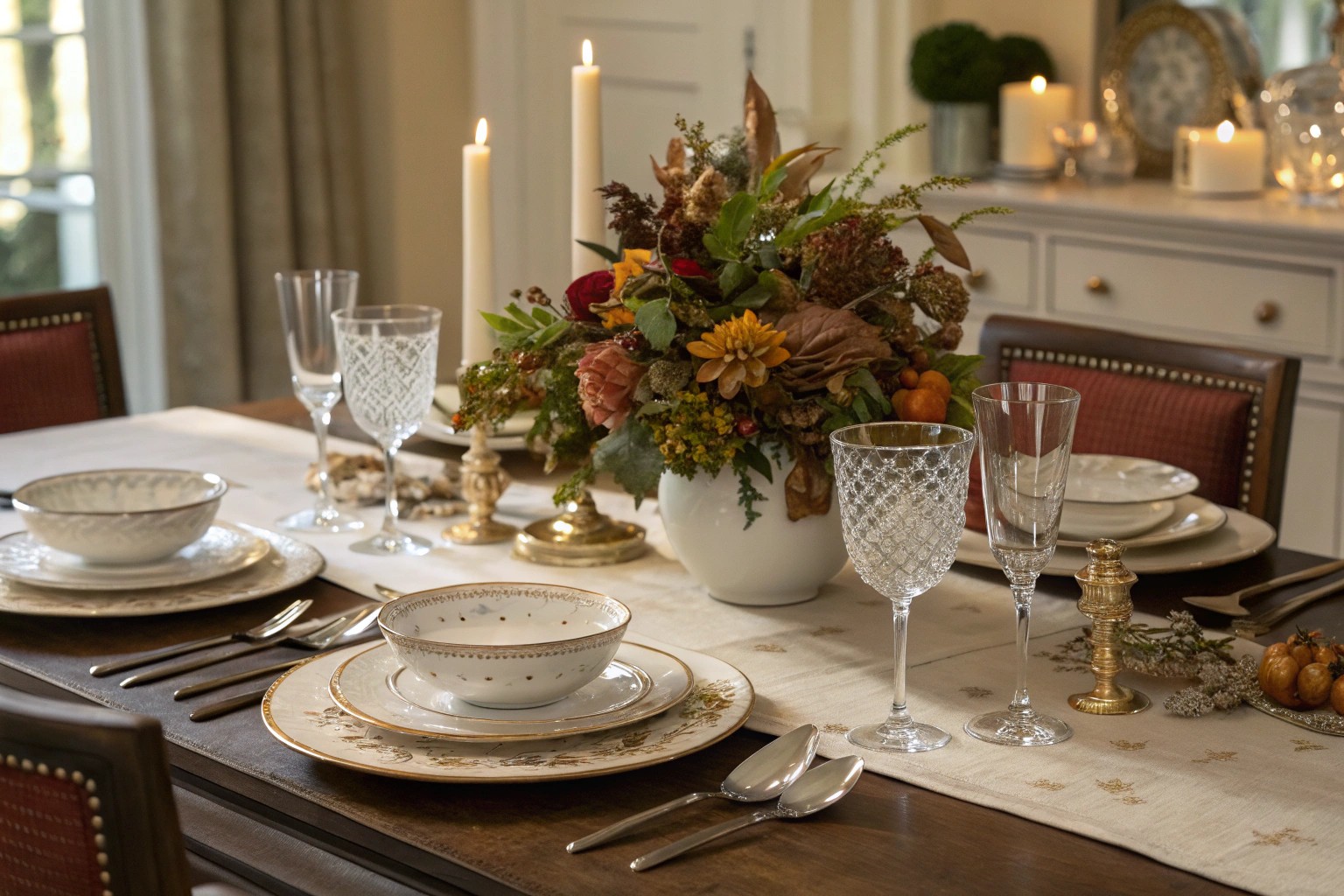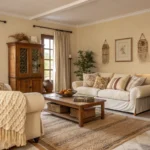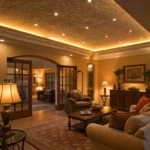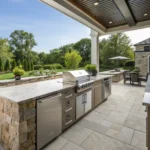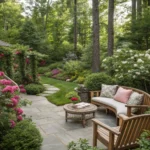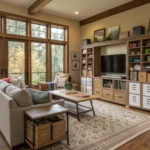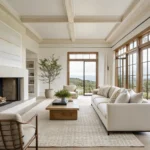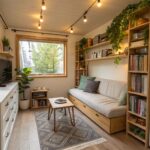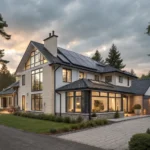Creating a tablescape that serves as both functional dining space and permanent home décor transforms your dining area into a living, breathing focal point that evolves with the seasons. Rather than clearing everything away after each meal, these enduring arrangements become part of your home’s daily rhythm while maintaining their beauty and purpose year-round.
Understanding the Permanent Tablescape Philosophy
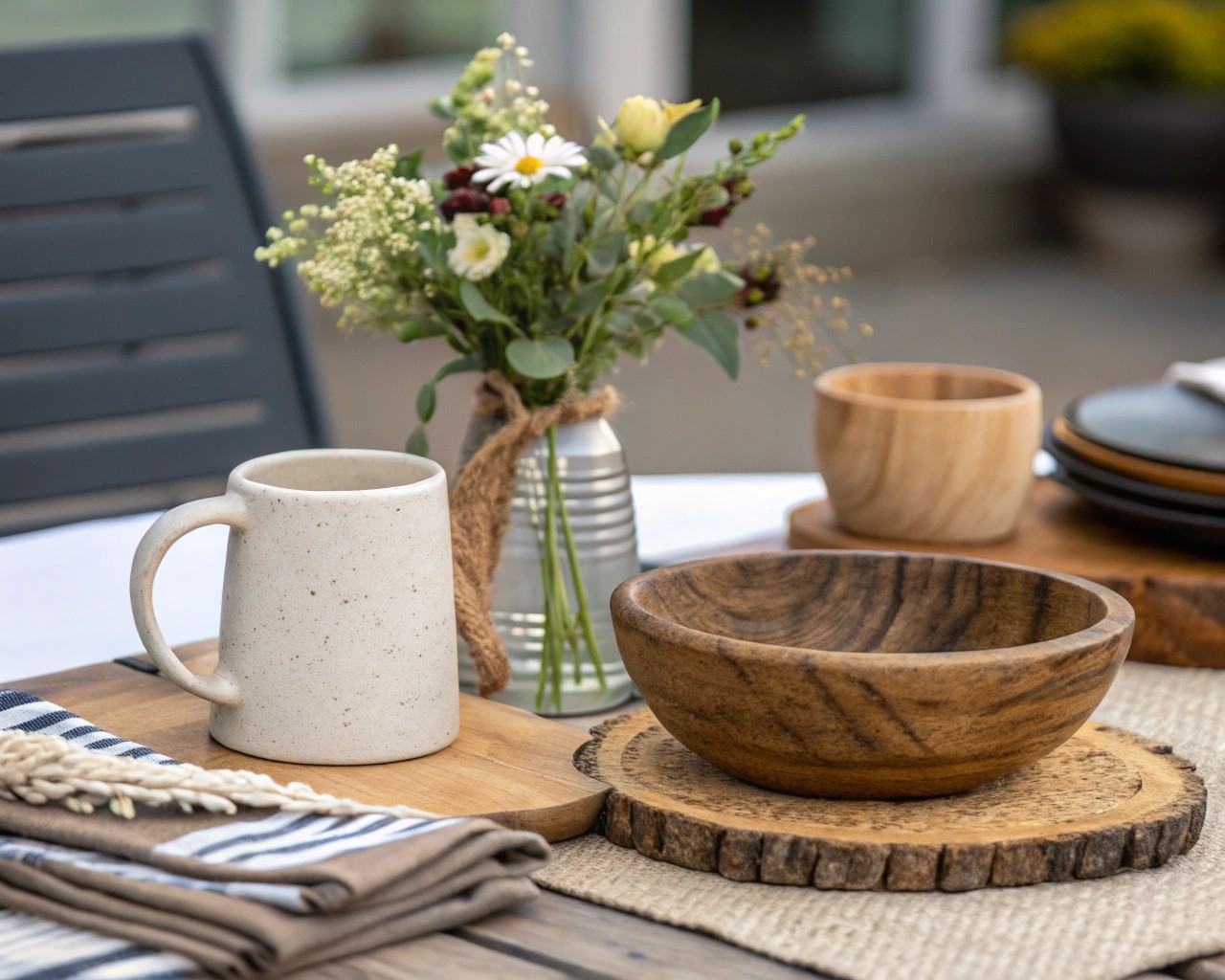
The concept of a lasting tablescape differs fundamentally from traditional dinner party styling. While event tablescapes focus on momentary impact, permanent arrangements must balance aesthetic appeal with practical daily use. This approach treats your dining table as a canvas for ongoing artistic expression rather than a blank slate reset after each meal.
A successful permanent tablescape incorporates three core principles: durability, adaptability, and functionality. The elements you choose must withstand daily interaction, adapt to seasonal changes, and allow for comfortable dining without complete dismantling. I’ve found that clients who embrace this philosophy report greater satisfaction with their dining spaces, as these areas become true extensions of their personal style rather than occasional showpieces.
Key Characteristics of Lasting Tablescapes

Durability Features:
- Materials resistant to daily handling and cleaning
- Elements that maintain their appearance over time
- Components that can be easily refreshed rather than replaced
Functional Integration:
- Arrangements that accommodate place settings without disruption
- Heights that allow comfortable conversation across the table
- Easy-to-clean surfaces and materials
Visual Longevity:
- Color schemes that remain appealing across seasons
- Textures that add interest without overwhelming
- Proportions that suit both intimate and larger gatherings
Foundation Elements: Building Your Base
The foundation of any lasting tablescape begins with establishing a stable, attractive base that can support seasonal variations throughout the year. This base layer functions as your canvas, providing consistency while allowing for creative flexibility as your decorative needs change.
Choosing Your Primary Base Layer

When selecting foundation elements, prioritize neutral, high-quality materials that complement your dining room’s existing architecture and furnishings. A well-chosen base layer should feel intentional rather than default, supporting rather than competing with your seasonal additions.
Recommended Base Options:
| Material Type | Best For | Maintenance Level | Seasonal Flexibility |
|---|---|---|---|
| Linen table runners | Casual to formal settings | Medium | High |
| Natural jute placemats | Rustic, farmhouse styles | Low | Medium |
| Wooden charger plates | Traditional, modern farmhouse | Low | High |
| Stone or ceramic trivets | Contemporary, minimalist | Very Low | High |
The most successful permanent tablescapes I’ve designed incorporate layering techniques that create depth without overwhelming the space. Start with one substantial base element—perhaps a quality linen runner in a neutral tone—then build complexity through careful addition rather than accumulation.
Material Selection for Longevity
Natural Fiber Benefits:
- Hemp and linen runners develop attractive patina over time
- Cotton blends offer durability with easy care
- Jute provides texture while remaining cost-effective
- Organic materials align with sustainable living principles
Synthetic Advantages:
- Weather resistance for homes with varying humidity
- Stain resistance for families with children
- Color retention through repeated washing
- Consistent texture and appearance over time
Seasonal Adaptation Strategies
Creating tablescapes that transition gracefully through seasons requires understanding how to modify core elements rather than completely replacing them. This approach maintains visual continuity while acknowledging the natural rhythm of seasonal change that influences our decorating instincts.
Spring Renewal Approach
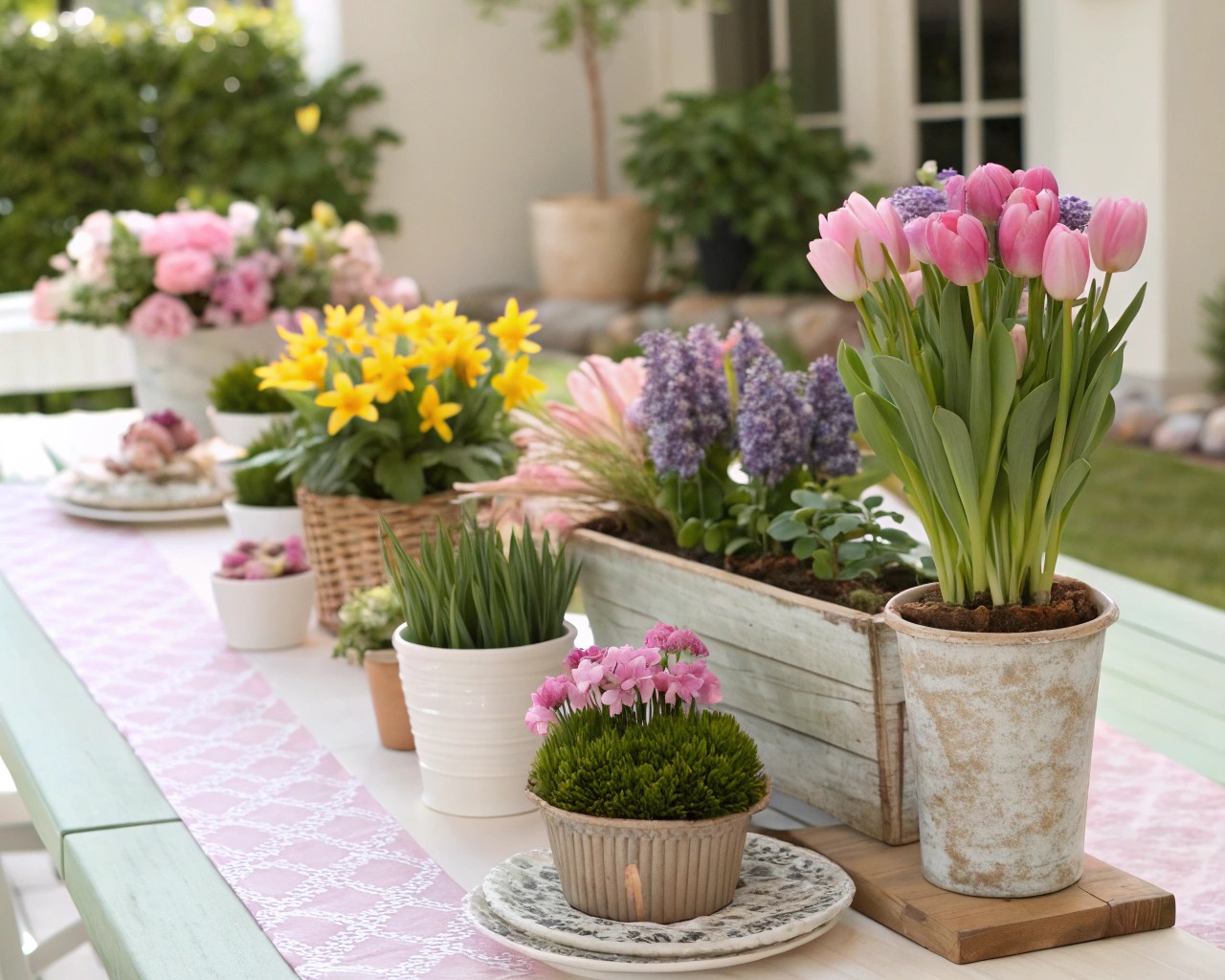
Spring tablescapes benefit from incorporating living elements that literally grow and change throughout the season. Rather than static arrangements, consider potted plants that can serve dual purposes as both centerpiece and eventual garden additions.
Spring Implementation Strategy:
- Group small potted flowering plants in a large, waterproof container
- Choose plants like primroses, small daffodils, or herbs that can later be transplanted
- Use moss or decorative stones to create cohesive planting scenes
- Incorporate fresh branches with budding leaves for vertical interest
The key advantage of this living centerpiece approach lies in its evolution throughout the season. As plants grow and change, your tablescape maintains visual interest without requiring constant intervention. I often recommend this method to clients who appreciate garden-to-table aesthetics but lack extensive outdoor growing space.
Summer Abundance Techniques
Summer tablescapes can embrace bolder colors and more abundant arrangements while maintaining the practical requirements of frequent outdoor entertaining. This season allows for experimenting with fruit-based displays that serve both decorative and functional purposes.
Functional Summer Elements:
- Large wooden bowls filled with seasonal fruits
- Herb plantings in attractive containers (basil, rosemary, thyme)
- Lightweight fabrics that can be easily laundered
- Elements that transition from indoor to outdoor use
Autumn Transition Methods
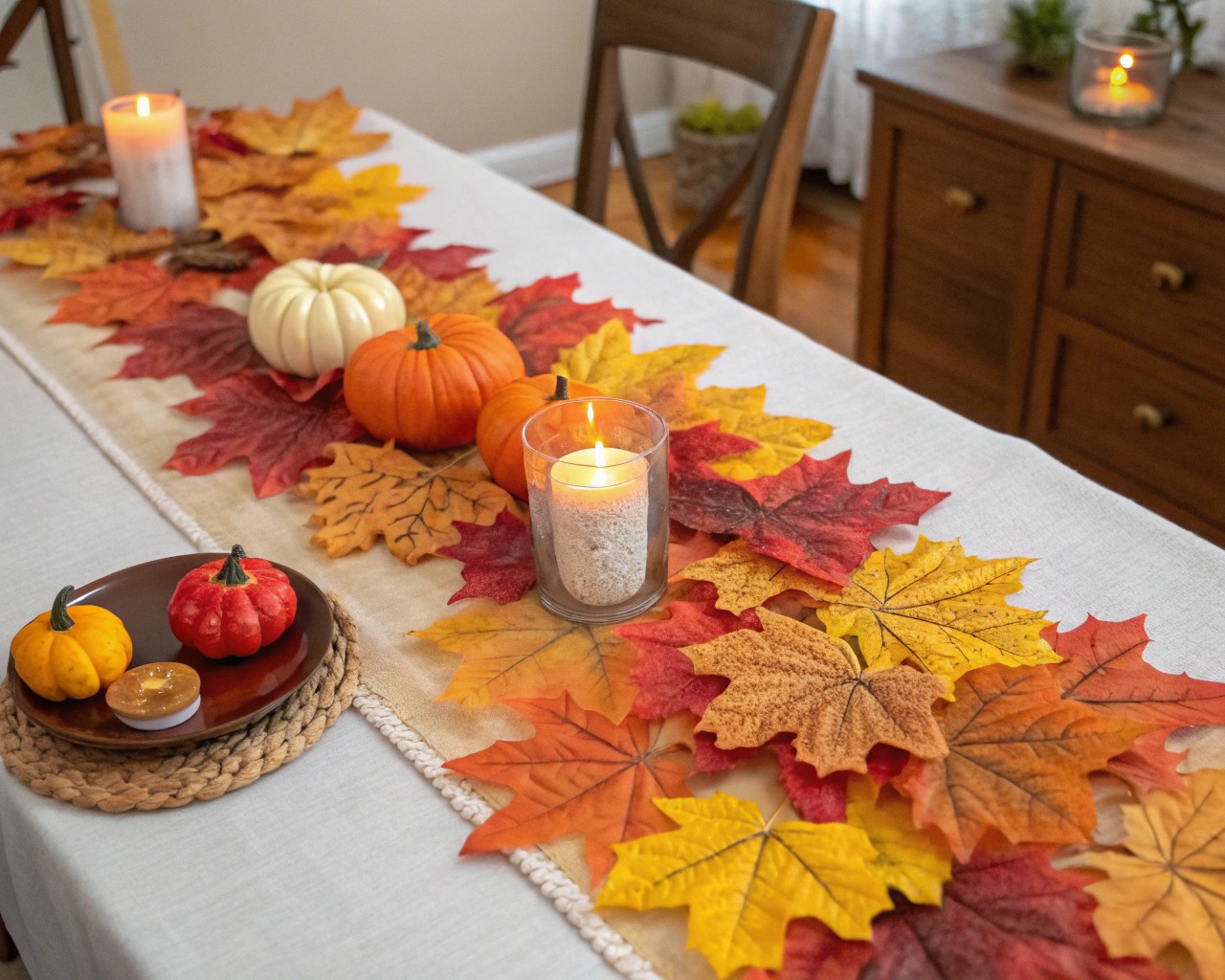
Fall provides the richest opportunity for creating tablescapes with natural, found materials that cost nothing but provide substantial visual impact. This season’s abundance of natural decorative elements makes it ideal for those seeking budget-friendly approaches to table styling.
Autumn Natural Materials:
- Pine cones, acorns, and seed pods collected during walks
- Branches with colorful leaves (maple, oak, dogwood)
- Small pumpkins and gourds that last for months
- Dried wheat stalks or other grain materials
The scientific principle behind autumn’s decorative success lies in the natural preservation processes occurring in these materials. Lower moisture content and natural protective compounds help these elements maintain their appearance far longer than spring flowers, making them ideal for permanent displays.
Winter Sophistication Standards
Winter tablescapes require sophisticated restraint, focusing on texture, form, and subtle color variations rather than bright florals. This season rewards careful attention to proportion and quality over quantity.
Winter Design Elements:
- Evergreen arrangements that provide fragrance and color
- Metallic accents that reflect available light
- Candles and lighting elements for ambiance
- Rich textures like velvet, wool, or faux fur accents
Living Centerpiece Systems
Incorporating living plants into permanent tablescapes creates dynamic arrangements that evolve naturally while requiring minimal maintenance. These systems work particularly well for households that enjoy gardening but want to extend that interest into interior design.
Succulent Integration Methods
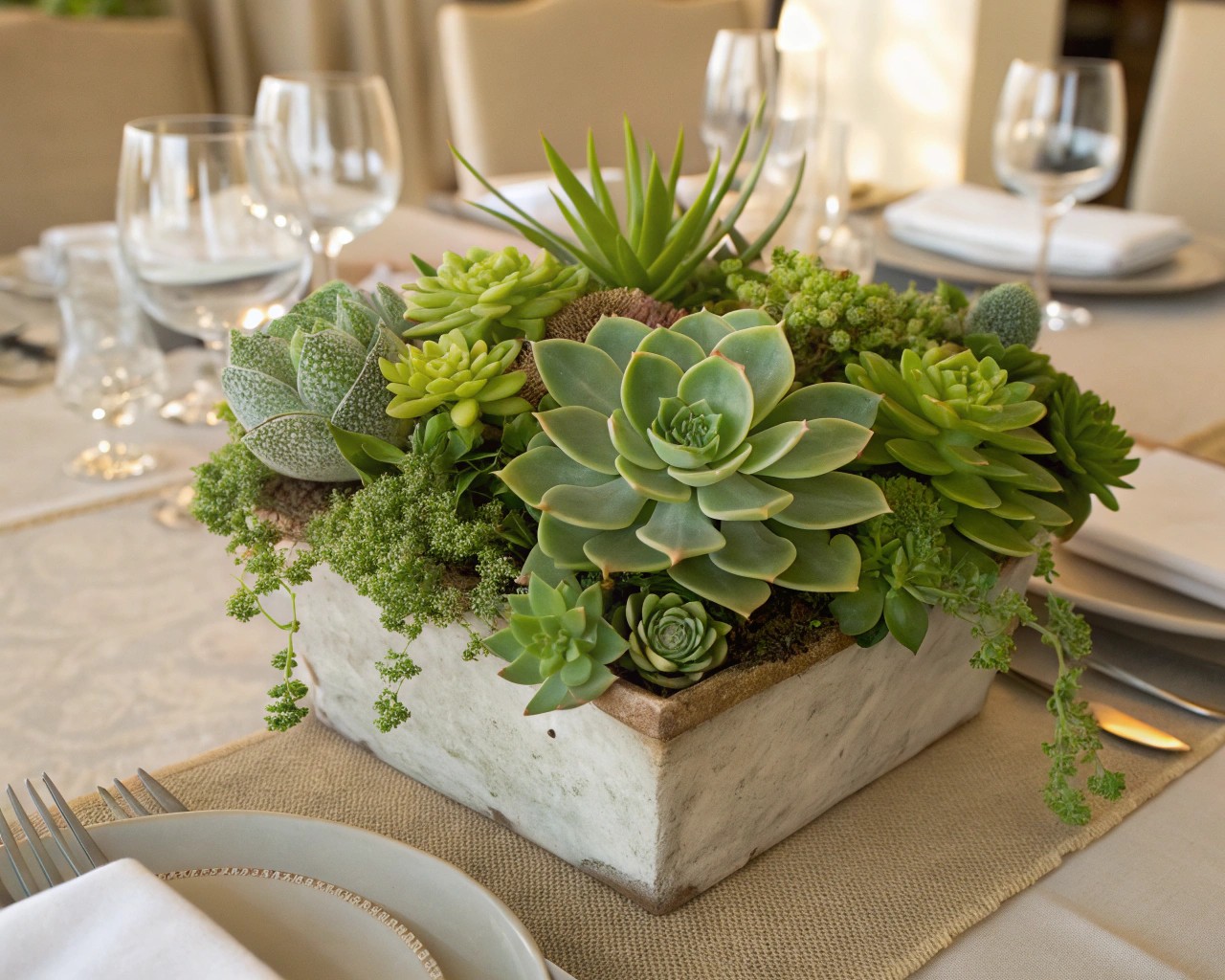
Succulents offer exceptional value for permanent tablescapes due to their low maintenance requirements and architectural forms that complement both modern and traditional décor styles. Their ability to thrive in various lighting conditions makes them suitable for most dining room environments.
Succulent Arrangement Principles:
- Choose containers with proper drainage or create false-bottom systems
- Group plants with similar water and light requirements
- Vary heights and textures for visual interest
- Plan for seasonal color changes in many succulent varieties
I particularly recommend echeveria and aeonium varieties for their rosette forms that create natural focal points without overwhelming smaller dining spaces. These plants can survive occasional neglect while providing consistent beauty throughout the year.
Herb Garden Centerpieces
Incorporating edible plants into tablescapes serves both aesthetic and culinary purposes, creating a garden-to-table connection that enhances both cooking and entertaining experiences. Herb centerpieces work especially well for families who enjoy cooking together or hosting casual dinner parties.
Recommended Herb Combinations:
- Mediterranean mix: Rosemary, thyme, oregano, lavender
- Culinary basics: Basil, parsley, chives, sage
- Aromatic blend: Mint varieties, lemon balm, scented geraniums
- Winter hardy: Rosemary, sage, thyme, winter savory
Care Requirements:
- Weekly watering checks (avoid overwatering)
- Monthly feeding with diluted liquid fertilizer
- Regular harvesting to maintain shape and encourage growth
- Rotation toward light sources if necessary
Seasonal Plant Rotation
Developing a rotation system for living centerpieces ensures year-round interest while accommodating plants’ natural growth cycles and seasonal requirements. This approach works particularly well for gardeners who want to maintain connection with growing things throughout winter months.
Rotation Schedule Example:
| Season | Primary Plants | Supporting Elements | Maintenance Notes |
|---|---|---|---|
| Spring | Flowering bulbs, herbs | Fresh branches, moss | High water needs |
| Summer | Heat-tolerant herbs, succulents | Fruit displays, lightweight fabrics | Monitor for pests |
| Fall | Ornamental grasses, late herbs | Natural materials, warm colors | Reduce watering |
| Winter | Evergreen arrangements, forced bulbs | Metallic accents, candles | Minimal water needs |
Sustainable Material Choices
Embracing sustainable materials in permanent tablescapes aligns with both environmental consciousness and practical longevity. These choices often prove more economical over time while supporting local artisans and reducing environmental impact.
Natural Material Integration
Locally-Sourced Options:
- Driftwood pieces for coastal regions
- River rocks and stones for inland areas
- Native plant materials (with permission where required)
- Reclaimed wood elements from local sources
The advantage of using locally-sourced materials extends beyond environmental benefits. These elements naturally complement your region’s architectural styles and seasonal patterns, creating tablescapes that feel authentically connected to place rather than generically decorative.
Eco-Friendly Fabric Choices
Sustainable Textile Options:
- Organic cotton in natural, undyed colors
- Hemp fabric runners and napkins
- Linen from certified sustainable sources
- Recycled fabric blends from post-consumer materials
When selecting sustainable fabrics, consider their end-of-life disposal as well as their initial environmental impact. Natural fibers can be composted when they reach the end of their useful life, while synthetic blends may offer greater durability during use.
Repurposing and Upcycling Strategies
Creative Repurposing Ideas:
- Mason jars as bud vases or candle holders
- Vintage books as pedestals for small arrangements
- Old wooden boxes as planters with proper lining
- Glass bottles as single-stem vases
I’ve found that clients often possess items perfect for tablescape integration without realizing their potential. A quick inventory of storage areas frequently reveals containers, fabrics, and decorative objects that can be repurposed for table styling with minimal investment.
Advanced Layering Techniques
Mastering the art of layering creates visual depth and sophistication in permanent tablescapes while maintaining the flexibility necessary for daily dining use. This technique requires understanding how different textures, heights, and materials interact to create cohesive yet dynamic arrangements.
The Three-Layer System
Professional designers rely on a three-layer approach that creates visual hierarchy without overwhelming the space. Each layer serves a specific function while contributing to the overall aesthetic impact.
Layer One: Foundation
– Table runner or series of placemats
– Provides color base and protects table surface
– Should cover 60-70% of table length for visual balance
Layer Two: Structure
– Medium-height elements like small plants or decorative objects
– Creates visual anchors and defines space
– Typically includes 3-5 elements for optimal visual impact
Layer Three: Accent
– Tallest elements like candles, branches, or flowers
– Provides vertical interest and draws the eye upward
– Should not exceed 12-14 inches to maintain conversation flow
Height Variation Principles
Creating pleasing height variations requires understanding the mathematical relationships that our eyes find naturally appealing. The most successful arrangements follow odd-number groupings and proportional height relationships.
Effective Height Ratios:
- Shortest elements: 4-6 inches
- Medium elements: 8-10 inches
- Tallest elements: 12-14 inches
- Maintain roughly 2:3:4 proportional relationships
Practical Height Guidelines:
- No element should block sight lines across a standard dining table
- Candles should be either very low (under 6 inches) or quite tall (over 12 inches)
- Avoid the “airport runway” effect of uniform heights
- Group elements in odd numbers for most pleasing visual impact
Texture Mixing Strategies
Complementary Texture Combinations:
- Smooth ceramics with rough natural materials
- Soft fabrics with hard metallic accents
- Glossy surfaces with matte finishes
- Fine textures with bold, chunky elements
The scientific basis for successful texture mixing lies in how our brains process visual information. Contrasting textures create interest without requiring contrasting colors, making this technique particularly valuable for neutral color schemes that need visual excitement.
Practical Implementation Guide
Transitioning from inspiration to actual tablescape creation requires systematic planning and realistic timeline expectations. Most successful permanent tablescapes develop over several months rather than in a single decorating session.
Budget-Conscious Approach
Phase One Investment ($50-75):
- Quality table runner or cloth in neutral color
- Basic collection of glass votives or small containers
- One substantial centerpiece element (large bowl, plant, or decorative object)
Phase Two Additions ($25-50):
- Seasonal rotation materials (candles, small plants, natural elements)
- Additional height-varying containers or platforms
- Complementary napkins or placemats in coordinating colors
Phase Three Refinements ($30-60):
- Higher-quality versions of successful elements
- Specialized containers for living plants
- Professional-grade candles or lighting elements
Timeline for Development
Week 1-2: Foundation Installation
– Select and install primary base layer
– Establish basic height relationships with temporary elements
– Test daily functionality with actual meals
Week 3-4: Element Addition
– Introduce seasonal elements gradually
– Adjust proportions based on daily use patterns
– Document successful combinations with photos
Month 2-3: Seasonal Transition
– Practice rotating elements for seasonal changes
– Identify which components work across multiple seasons
– Refine maintenance routines for living elements
Month 4+: System Optimization
– Replace temporary elements with permanent solutions
– Establish supply sources for consumable elements (candles, flowers)
– Create storage system for seasonal rotation materials
Maintenance Scheduling
Daily Tasks (2-3 minutes):
- Quick visual check of living plants
- Straighten displaced elements after meals
- Wipe surfaces with appropriate cleaners
Weekly Tasks (10-15 minutes):
- Water living plants as needed
- Replace any expired natural elements
- Dust or clean decorative objects
Monthly Tasks (30-45 minutes):
- Deep clean all elements and surfaces
- Assess and replace any worn components
- Plan next season’s transition elements
Quarterly Tasks (1-2 hours):
- Complete seasonal element rotation
- Evaluate overall system effectiveness
- Purchase supplies for upcoming seasons
Troubleshooting Common Challenges
Even well-planned permanent tablescapes encounter practical challenges that require creative solutions. Understanding these common issues and their remedies prevents frustration and helps maintain long-term success.
Space Limitation Solutions
Small Table Strategies:
- Focus on vertical rather than horizontal arrangements
- Use wall-mounted elements to extend visual space
- Choose dual-purpose items that store within arrangements
- Emphasize quality over quantity in element selection
Large Table Challenges:
- Create multiple focal points rather than single centerpiece
- Use linking elements (runners, scattered votives) for continuity
- Establish conversation zones with strategic groupings
- Maintain clear sight lines between seating areas
Maintenance Simplification
Low-Maintenance Plant Alternatives:
- Air plants require minimal care and create modern appeal
- Preserved moss maintains green color without watering
- High-quality artificial plants offer realistic appearance
- Dried materials provide texture without ongoing care requirements
Seasonal Transition Shortcuts:
- Develop standard formulas for each season’s arrangements
- Create storage containers labeled by season
- Photograph successful arrangements for easy replication
- Maintain supply inventory for quick transitions
Style Evolution Management
Permanent tablescapes should evolve with changing tastes and life circumstances rather than becoming static displays. Building flexibility into your system accommodates these natural changes without requiring complete redesign.
Adaptation Strategies:
- Invest in neutral foundations that accommodate style changes
- Choose element holders that can display various materials
- Document successful combinations for future reference
- Plan for gradual rather than dramatic transitions
Seasonal Maintenance Calendar
Developing a systematic approach to seasonal maintenance ensures your permanent tablescape remains fresh and appealing throughout the year while minimizing time investment and maximizing visual impact.
Spring Preparation (March-May)
Early Spring Tasks:
- Assess winter arrangements for worn elements
- Plan living plant integration for growing season
- Clean and prepare containers for seasonal transitions
- Source new materials from garden centers and nature walks
Plant Integration Timeline:
- Week 1: Select appropriate container plants for indoor use
- Week 2: Establish watering and light requirements
- Week 3: Arrange plants with supporting decorative elements
- Week 4: Fine-tune arrangement based on plant response and family use patterns
Summer Optimization (June-August)
Heat Management Strategies:
- Relocate light-sensitive plants away from direct sunlight
- Increase watering frequency for living elements
- Choose heat-resistant decorative materials
- Plan for increased entertaining and outdoor-indoor transitions
Practical Summer Adjustments:
- Lightweight fabrics that launder easily
- Minimal wax candles that might soften in heat
- Fresh fruit displays that can be consumed regularly
- Elements that transition easily to outdoor dining spaces
Autumn Preparation (September-November)
Natural Material Collection:
- Early autumn: Begin collecting preserved materials during peak color
- Mid-autumn: Process and prepare materials for arrangement
- Late autumn: Create transition arrangements bridging to winter themes
Preparation Techniques:
- Press colorful leaves between heavy books
- Air-dry seed pods and interesting branches
- Preserve smaller materials in sealed containers
- Document collection locations for future reference
Winter Maintenance (December-February)
Indoor Focus Strategies:
- Emphasize candlelight and artificial illumination
- Use rich textures to add warmth and interest
- Incorporate evergreen materials for natural fragrance
- Plan for holiday entertaining without complete redesign
Light Optimization:
- Position arrangements to maximize available natural light
- Use mirrors or reflective surfaces to amplify illumination
- Choose light-colored elements to brighten dark winter months
- Consider battery-operated LED elements for consistent lighting

